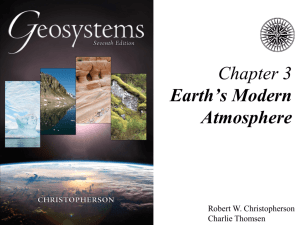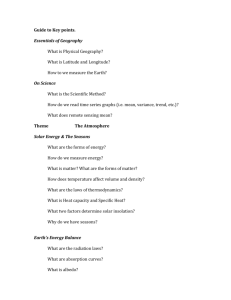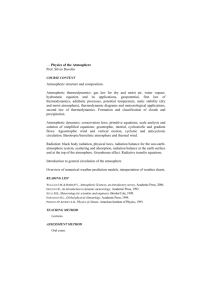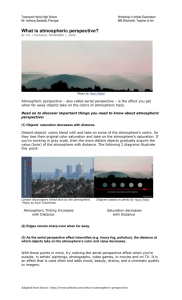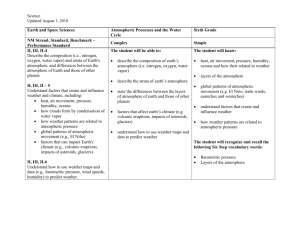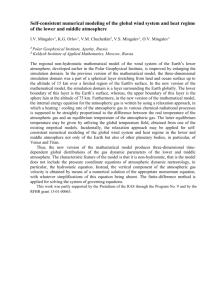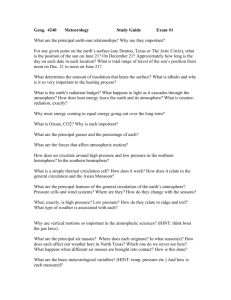ch03_Lecture
advertisement
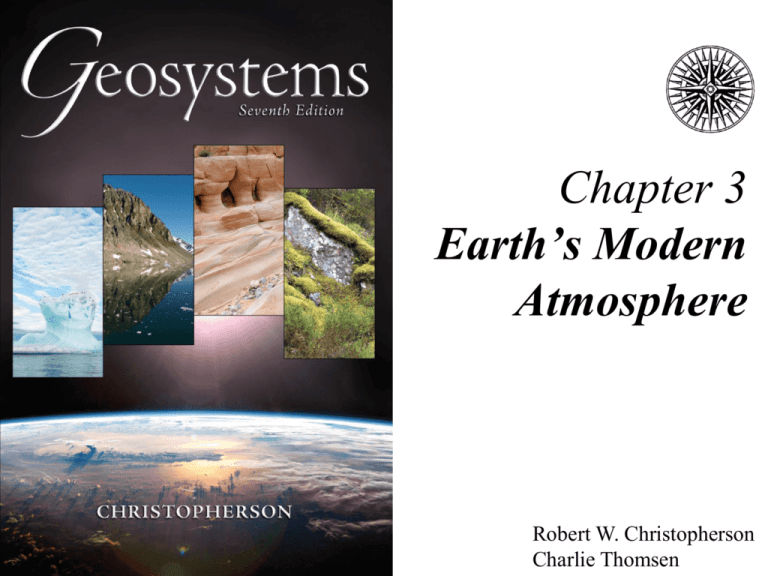
Chapter 3 Earth’s Modern Atmosphere Robert W. Christopherson Charlie Thomsen Earth’s Modern Atmosphere Atmospheric Composition, Temperature, and Function Variable Atmospheric Components Atmospheric Composition, Temperature, and Function Atmospheric Profile Atmospheric Composition Criterion Atmospheric Temperature Criterion Atmospheric Function Criterion Atmospheric Profile Atmosphere extends to 32,000 km (20,000 mi) from surface Thermosphere is at 480 km (300 mi)—top of the principal atmosphere Three criteria to examine atmosphere Composition Temperature Function Profile of Atmosphere Figure 3.2 Atmospheric Pressure Figure 3.3 Atmospheric Composition Heterosphere – outer atmosphere 80 km (50 mi) outward, to thermosphere Layers of gases sorted by gravity Homosphere – inner atmosphere Surface to 80 km (50 mi) Gases evenly blended CO2 increase 1958–2007 Figure 3.4 Atmospheric Temperature Thermosphere Roughly same as heterosphere 80 km (50 mi) outward Mesosphere 50 to 80 km (30 to 50 mi) Stratosphere 18 to 50 km (11 to 31 mi) Atmospheric Temperature Troposphere Surface to 18 km (11 mi) 90% mass of atmosphere Normal lapse rate – average cooling at rate of 6.4 C°/km (3.5 F°/1000 ft) Environmental lapse rate – actual local lapse rate Temperature Profile Figure 3.6 Atmospheric Function Ionosphere Absorbs cosmic rays, gamma rays, X-rays, some UV rays Ozonosphere Part of stratosphere Ozone (O3) absorbs UV energy and converts it to heat energy Protective Atmosphere Figure 3.7 Antarctic Ozone Hole 2006 Figure FS 3.1.1 ClO and O3 Figure FS 3.1.2 Variable Atmospheric Components Natural Sources Natural Factors That Affect Air Pollution Anthropogenic Pollution Benefits of the Clean Air Act Natural Factors That Affect Air Pollution Winds Local and regional landscapes Temperature inversion Southern California Wildfires Figure 3.8 Temperature Inversion Figure 3.10 Anthropogenic Pollution Carbon monoxide Photochemical smog Industrial smog and sulfur oxides Particulates Forests on Fire Figure 3.12 Air Pollution Figure 3.14 Photochemical Smog Figure 3.15 Benefits of the Clean Air Act Total direct cost $523 billion Direct monetized benefits $5.6 to $49.4 trillion – average $22.2 trillion Net financial benefit $21.7 trillion 206,000 fewer deaths in 1990! End of Chapter 3 Geosystems 7e An Introduction to Physical Geography Robert W. Christopherson Charlie Thomsen


